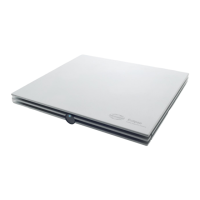Eclipse Additional Information Page 134
6.4.2.2 EEG
The EEG is shown in both the ASSR tab and the Audiogram tab for right and left ear respectively, as shown
above. If the measurement is too noisy the curves turns red to indicate rejection.
The arrows in the center control the rejection threshold. The threshold is indicated by the numerical values
displayed at the vertical axis of the raw EEG displays. The threshold should be set, so any short term growth
of the EEG is rejected. Ideally a rejection level of 20µV should be selected, as that will provide the most relia-
ble recordings. This, however, may not be possible with typical restless patients.
The system will allow you to adjust this rejection level within certain limits. Before starting the test, the ampli-
fier gain is also adjusted by these controls to be suitable for the selected rejection threshold. After the test is
started, the rejection threshold can be changed within certain limits. If change is needed beyond these limits,
stop the test while doing the change, as this will allow the gain of the Preamplifier to be reset to reflect the
needs of the new rejection threshold.
6.4.2.3 Frequency Curves
Each frequency has its own curve area. The curves indicate ongoing or completed results obtained for the
various stimuli presented for the particular frequency. The x-axis indicates the test time for the curve, while
the y-axis indicates the response confidence. Color coding of the probability curves is default, so ongoing
recordings are black, recordings at 100% are green and curves not reaching 100% are red.
Highlighting a specific curve can be practical if the screen holds many curves. Just click on the handle
(square box with intensity) of any curve to highlight it.
Note that the indicated residual noise corresponds with the curve highlighted. The residual noise value is
listed as number in the table.
Note The “handles” containing the stimulus intensity information also indicate whether 90Hz stimulation rate
or 40Hz stimulation rate was use, as the 40Hz tests holds a small asterisk (*).

